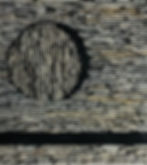
Etty Hasak had an established career in the arts well before first coming to mosaics in 2006. She originally studied studio art just outside of Tel Aviv and worked in galleries and framing in addition to her studio practice. In the late 90’s, she expanded her practice to ceramics, and added mosaics not long afterward.
Since then, Etty has developed a body of ceramic and mosaic work that is strongly influenced by earthy, natural textures and colors. Though she transitioned into mosaic with a ceramicist’s mindset, emphasizing clay and picassiette, her current work incorporates a wide range of tesserae materials including ceramic elements, natural stone with variegated patterning, particularly slate with warm iron inclusions, vibrant smalti, and metallic elements that catch the eye. She often draws inspiration from the natural world to create richly textured works that play with biological similitude, using dark matte surfaces to mimic the roughness of tree bark or green glass to recreate the waxy luster of a leaf. In stunning contrast, Etty’s frequent but highly selective use of blue or red smalti, gold, or copper elements punctuates the earthiness of her compositions with gleaming liquidity.
Today Etty shares some observations on her approach and motivations in her art.
GoCM: What kinds of aesthetic experiences do find to be most impactful on your work?
EH: I believe we carry in us all that we saw, studied, encountered and experienced throughout our lives. When I create a new work it is influenced by all that. Part of these experiences is how we react to texture and what it invoke in us. I always react strongly to texture, wether it is found in nature or in a piece of rust I found under a bridge. It is always a big influence on my work.
Taking Dugald McInnes's class I felt a secret door opened for me and with guidance from other artists like Maestro Verdiano Marzi, Sue Giannotti and Karen Ami, I now have the tools to voice all that through my work.
GoCM: What motivated you to transition from ceramics into mosaic making, and how do you integrate the two practices?
EH: I fell in love with mosaic from the first class I took in this medium about 12 years ago. Everything in my way was covered in mosaic and my garage soon filled up with materials to be used in future mosaics. When I found the Chicago Mosaic School, each class/ workshop I took I discovered a new layer that helped me find my voice as a mosaic artist. It changed my practice and brought it to a different level.
For a long time clay work was my primary medium. When I discovered mosaic, my broken ceramic pieces became integral part of my mosaic creations along with other materials. Taking classes at CMS introduced me to new materials and clay was pushed to the wayside. I love the texture created in mosaic. The quality each material brings to the final artwork and how it influences us as viewers. The search for certain "feel" brought me back to work with clay, this time creating my tesserae from clay in a deliberate way so I completely control the outcome for my mosaic.
GoCM: Do you have a particular method for approaching new works, and if so, what does that look like?
EH: It is hard to say, since the process is not always the same. It always start with an idea brewing in my head. Sometimes I put it on paper in very general outlines just so it doesn't disappear. At times, this is where it ends.
Other times It becomes words that work themselves to an idea or become part of the work itself. But I always let the work dictate where it goes with what I wish to express. Some works are created easily, others have a more complicated delivery and lots of "problems" on the way. I discovered "problems" often force me to be more creative and reveal things I haven't necessarily considered.
GoCM: When you imagine a finished piece of artwork, do you have an intended audience, or a particular intention for your work’s relationship with the world?
EH: As an artist I want the audience to value my work, but I don't think the audience is ever in my mind during the process of creating a work.
When I make a piece for a show under a certain criteria, I run the subject in my mind and try to find how it resonates with me. From there an idea will start to show up. Most of my works are what I need/ want to express. After the work is done, I'm done and I can let go of the work even if it is very personal.
GoCM: What would you consider the biggest challenge facing you as an artist today?
EH: Self doubt which includes exposing myself in all aspects.
GoCM: In the future, where do you see your practice going?
EH: I wish to be able to continue creating and developing my artwork, exhibiting and teaching.



